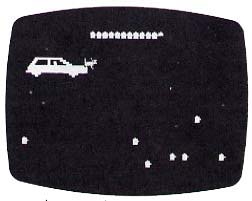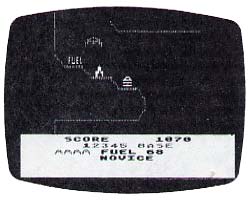Dog Daze and Caverns of Mars
Dog Daze
|
We had just finished a picnic lunch of barbecued spareribs. I was walking the dog and as usual, when we passed a fire hydrant, he insisted upon investigating it, dragging me along on the end of the leash. David quickly grabbed a chewed bone, threw it, and hit the fire hydrant. "It's mine," he shouted gleefully.
David and I are not insane, just currently addicted to an APEX (Atari Program Exchange) game called Dog Daze. Now, I readily agree that the game concept which uses two dogs, fire hydrants, bones, and an occasional automobile doesn't sound as thrilling as being invaded by aliens. Furthermore, I will concede that the graphics are not as fancy as the ones in Centipede or PacMan. Then, you ask, just what is so good about Dog Daze? Why should I buy it? That's very simple to answer. The game is fun to play.
Dog Daze opens with the melody of "How Much Is That Doggy in the Window," then plots a play area and two dogs, each a different color. Along the top of the play area is a row of sixteen fire hydrants, eight of one color, and eight of the other. These fire hydrants keep score.

|
The object of Dog Daze is to get all the fire hydrants at the top of the play area your dog's color.
You maneuver your dog with the joystick, causing him to run vertically, horizontally, or diagonally across the playfield. Neutral fire hydrants (colored blue) appear on the playfield in random locations, and your dog must run to "claim" it. When the hydrant is claimed, it turns to the color of the dog that claims it.
You can claim a neutral hydrant one of two ways. One way is to run and touch each of the hydrants as they appear, thereby changing them to your color. The other strategy is to throw your bone at it by pressing the joystick button. If you hit it, you claim the hydrant, and get your bone back automatically. If you miss, you must retrieve your bone before you can throw it again.
In the meantime, your opponent is trying to do the exact same thing, making for a furious competition to be the first to claim the neutral hydrant.
There are several hazards to be avoided. If you pass too close to your opponent's hydrant, like all dogs, you must stop to sniff for a few seconds. While you are sniffing, your opponent's dog may be claiming all the neutral hydrants in sight.
An even more serious hazard is the car that periodically swerves across the playfield. It sounds a warning honk, but if you are in the path or stuck to a hydrant in its path, you may be hit and lose the game.
Scores are calculated based on two events: each time you claim a hydrant, one-half of one of the hydrants on top of the play area changes to your color and each time you run into the other dog's hydrant, one-half of one of your hydrants changes to his color.
The only options allowed in Dog Daze are to limit the length of the game, which is default sixteen minutes, and to handicap yourself by starting with fewer than eight fire hydrants of your color. This allows a skilled player to play with someone who is less skilled.
Sound is used quite imaginatively. A variety of bleeps, bonks, and various degrading noises (when you make mistakes) are generated. The dogs are animated quite nicely; the running motions are done very well. The author obviously took great care in designing his player tables.
Dog Daze is also one of the few two player games which allows both competitors to play at the same time. Most games use an "I go first, you go second" approach.
In summary, Dog Daze is an excellent game. It combines the capabilities of the Atari and an unusual game concept to achieve a truly enjoyable game.
Caverns of Mars
|
The Caverns of Mars arrived recently. I had heard rumors about this new Atari game, so I immediately sat down to play it and see what all the fuss was about.
Four minutes later. I was hooked.
Four hours later, my wife dragged me away.
The plot is as follows (some of it is somewhat clichˇ, as it follows the lead of many, many other games.): First, there's the Sole Defender syndrome common to many games, where you alone are responsible for saving the Moon Base (Invaders) or six cities (Missile Command) or eighteen little people (Defender) or whatever. In this case, you are responsible for destroying a Martian base. In order to do so, you must penetrate a series of caverns to the lowest level, where an explodable device sits; arm it and start the countdown (by touching it); then escape before it goes off.
Should you succeed the first time, you must go through the same thing a second time, but with added obstacles, twistier corridors, and the like.
The game starts with you at the top of the cavern. It begins slowly scrolling up, so you move downward. By moving the joystick right-left you can maneuver from side to side (from a central position), and by moving it back and forth, you can increase or decrease your rate of descent.
If you pull the stick so that your ship moves upward on the screen, your ship matches the vertical speed of the caverns scrolling up past you. So your position relative to those caverns doesn't change; you have no vertical speed. But this can only last until your ship hits the top of the screen, at which point your relative velocity returns to normal. Similarly, if you move your ship downward, your velocity relative to the cavern walls is double that of no-motion.
This concept is what makes the Caverns so interesting, and difficult. If you don't move vertically, your rate of descent is constant and there are many places you must stop moving vertically to avoid running into the cavern walls (such as horizontal passages).

|
While you are descending through scenic Mars, you must destroy various installations. By pressing the joystick button, you launch two missiles downward from each side of your ship. If you hit a fuel canister (imaginatively labelled "FUEL") your fuel supply increases by 5 (of 100). If you hit other installations, you just plain destroy them. The idea is to wreak as much havoc as possible on the way down.
You can see only a limited section of the caverns. So you never know what's going to come next. You maneuver through a passageway twisting back and forth, and suddenly the screen is filled with Martian ships you must avoid, and try to blow up. But you must not collide with the ships or the wall.
If your first descent is successful you begin again. This time there are floating space mines, and force doors that open and close, and things begin to shoot back at you. Completely horizontal passages appear, requiring you to be ready for them and use nearly the full vertical screen's worth of maneuvering to get through. It gets harder and harder until you are destroyed, or somehow succeed in navigating all five caverns.
Technically, the game is excellently implemented. It's apparently done with remapped character graphics, letting the characters serve as the walls, ships, and so forth. Vertical scrolling is done smoothly and without flicker. The player tables for the ship are well laid out, and the missiles operate correctly. Sound is used well, with the usual explosions, rumbles, firing noises, and whatnot.
The Caverns of Mars has that indefinable "something" that makes it arcade-quality. Here's my best definition: When you lose in an arcade-quality game, you know why, and know how you could have done better, if you were just a little faster or if you hadn't have made that one mistake. Instead of the machine causing your destruction, it's your mistake that causes it. So, of course, you want to go back and try it again, and again, and get it right, until your fingers get cramps from holding the joystick, or until you're totally frustrated.
I recommend this game to anyone who likes fast-paced arcade games in the style of Asteroids or Missile Command and who is looking for a new challenge.
|
Table of Contents
Previous Section: Deluxe Invaders & K-razy Shootout
Next Section: Canyon Climber

